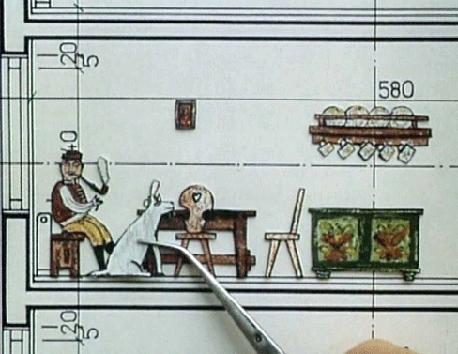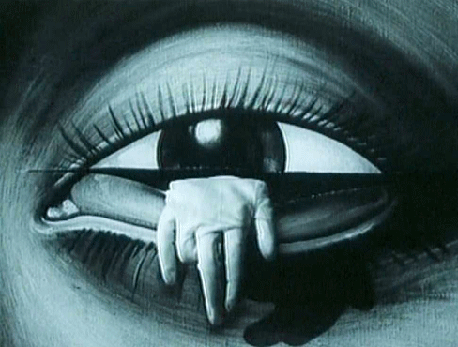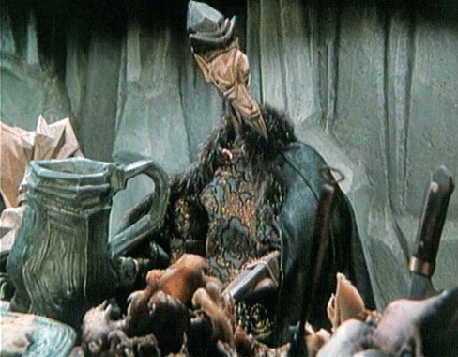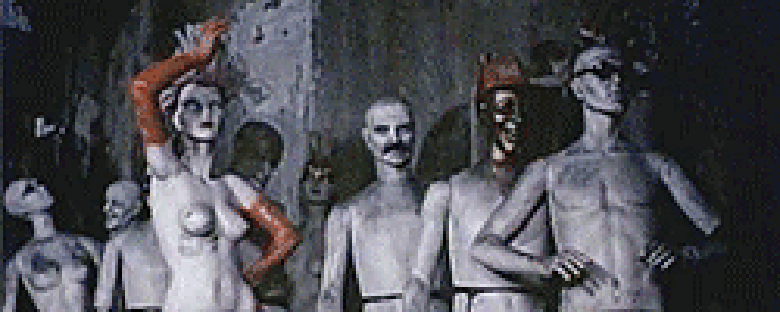Credits
Feature by: Jenny Jediny
Posted on: 17 June 2007
Related articles:
Features: What is Animation?
There is no doubt that Prague is regarded as a hub of animation in the European film world, primarily due to the genius of Jan Svankmajer. Svankmajer’s talent is complimented with accessibility—it is fortunate that his work has become so widely available, not merely on the festival circuit or in retrospectives, but also through home video and DVDs. This issue of availability has kept a number of Svankmajer’s colleagues out of sight for some time, both his influences and protégés. Jirí Barta is one such study; unlike Svankmajer, Barta’s work is not nearly as encompassing in its scope or output. Working primarily during the 1980s, Barta flourished during communist rule in the former Czechoslovakia, as funding was easily accessed through government grants, allowing students to develop at their own pace and direction. Initially dabbling with cutout shorts, Barta later experimented with stop-motion and puppetry, and within seven years of his first short completed The Pied Piper of Hamelin, still considered a masterpiece of Czech animation.
Like Svankmajer, Barta leans toward the grotesque in his imagery; sound is heavily emphasized, whether it is blood sloshing or a guttural, nonsensical tongue, providing a tactile quality to his characters and their universe. We recognize these objects, yet they inhabit a world of their own which often draws on the political issues of the former communist block. Surreal creations, ranging from mannequins to abandoned gloves, are intricately involved in symbolic demonstrations of the Velvet Revolution, or playfully comment on the rapid intrusion of materialism on Eastern Europe. Barta’s work is lighthearted, its overall tone more optimistic than Svankmajer in its criticism of society, despite extreme rigor for its morally inept characters.
Barta’s auteurist work has ceased over the past decade, as the director resorts to more commercial projects unseen on this side of the pond. Barta’s long-term pet project on The Golem, a legendary clay myth often connected to Frankenstein, has been held up since the early 1990’s, as producers frequently back out and artist grants remain scarce within the new Czech Republic.

Early works
The cutout technique employed by Barta in his earliest films, Disc Jockey and The Design humorously displays the influx of changes occurring during the early eighties in Eastern Europe; The Design takes urban development by way of wallpaper, blueprints and glue, as a layout of a housing complex is quartered off, and a multiethnic array of inhabitants are placed inside each designated “apartment,” a sketched box. The cutout technique allows Barta to modernize figures in motion; a goat has its horns pulled off, its tail molded until it morphs into a domestic dog, while a quaint farmer’s wife finds her bucket plucked out of her hands and replaced with a shiny sink. Barta’s coup is flattening these individuals until they are not merely silent, but black and white, indistinguishable figures pressed under layers upon layers of housing. In Disc Jockey, Barta expands on the alteration of Eastern European life with a flurry of materialistic images are pulled straight from 1950s American nostalgia. Pepsi cola, T-birds, and Shell gasoline signs whirr by as LPs play, turning and twisting into pastel colored cakes and pies. Barta’s colorful images are funky and have an air of amusement, not necessarily condemning the Westernization of communist culture, but instead reveling in its dizzying, palatable air.

Stop Motion/Puppetry
The Club of the Laid Off may be Barta’s most intricate expression of the Velvet Revolution. Mannequins haunt a warehouse loft, their lives dictated in a Pavlovian fashion. With a single ring, an alarm clock tumbles to the floor, and a male mannequin rises from bed, kisses his wife and walks downstairs to a makeshift desk, repetitious behavior that is mimicked by each of his companions; a little girl plays with ratty ball of yarn; a grandfather bangs on a radio, trying to reach a working frequency; a nude woman stares out the window while a man peers at her from behind a cloth curtain, poking a hole in the fabric in a rather overtly sexual fashion with his knobby wooden finger. Barta’s choice of mannequins, over clay or marionettes, emphasizes the obligatory behavior and regimented lifestyle associated with communism; the sounds of the mannequins’ joints creaking, of their heavy wooden footsteps reinforces the dull monotony of their lives. However, the onset of the revolution causes an abrupt intrusion into this eerie, antiquated world; new mannequins are delivered to the loft, and although the old ones are tossed into a dumpster, they make their way back to their space only to discover anarchy, as a new generation of punk-outfitted mannequins dance wildly, down vodka and copulate on the floor.
Among the references to changing social climates, myths and legends, and the organic, Barta’s The Vanished World of Gloves is an anomaly, a wicked homage to various film genres. An abandoned 16mm film projects a series of shorts featuring gloves — from lengthy opera gloves to cute mittens — reveling in Valentino-tinged romance as rival gloves face off for the love of their lady, and later reenacting the infamous eye slit from Un chien andalou. The short is completely charming, with shades of longing for an extinct era inhabited not merely by the featured accessory, but also by faded stars.
Barta’s playful visions extend beyond politics, as he ventures further into the natural world with A Ballad About Green Wood. An axe splits a log, and its splintered pieces come to life, skirting across the ground in a frenzied state. Barta cross cuts the activity of the logs with images of gushing streams and waterfalls, invoking a Rite of Spring worthy of Stravinsky. In bringing the logs to life through the stop motion technique, Barta conveys an almost pagan ritual in action; a log, attacked by a raven, undergoes a metamorphosis in a hybrid, birdlike creature only defeated by a wooden knight. The medieval nature of the piece, underscored by the “burning” of the creature — rather than flames, it goes up in greenery, as grass is tossed onto it, and it sprouts tiny leaves — brings Barta’s fondness for the ancient and mythological to the forefront, a theme he deftly returns to in The Pied Piper of Hamelin.

Krysar: A Short Masterpiece
The centuries old folk tale of The Pied Piper of Hamelin, already sinister in its connections to the bubonic plague and demonic actions, is propelled in a slightly different, but no less effective direction by Barta. With sets echoing German Expressionism, the inhabitants of Barta’s town in The Pied Piper live in a curiously archaic age; this distinctly individual world bears little to no resemblance to any genuine location or time, and yet ties into varying myths and familiar lore, particularly connecting to Barta’s preoccupation with materialism and its consequences.
The vulgarity and greed of Barta’s town is induced through striking images of gluttony; puppets feast on the heads of slaughtered pigs and guzzle their blood, while draping themselves in precious jewelry. Townsmen haggle over market prices, their tempers and blood vessels rising and nearly popping from their forehands with frustration over the loss of just one coin. Fashioned of rich, oak-toned wood, the puppets are hard, almost Cubist in appearance, modern figures in an ancient world, a sentiment echoed in their attachment to wealth. Their features, resembling awkward, ill-fitting puzzle pieces, directly contrast not only the mysterious Piper, whose angular features and cloak point toward a more Medieval era, but also the requisite moral compass of the town, a pale figure named Agnes whose soft features set her apart from her neighbors as much as her beliefs. While the Piper and Agnes are silent, introspective figures, the townsfolk speak in a garbled, nonsensical language whose high pitch is akin to the squealing of the vermin invading their homes.
The contrast of the puppets against the furry, darting, and clearly living bodies of the rats is striking, creating a clear dynamic that sets up the rodents as far more natural and driven (if only by a survival instinct) than their money-mongering counterparts. Refusing to pay the Piper, the town only sinks further into squalor, as Agnes is raped and murdered (in one of the more disturbing scenes in puppetry). Rather than returning to the traditional tale, there are no children led from the town but instead the townspeople themselves, hypnotized by the Piper’s tune and symbolically transformed into half rats as they march to the sea and drown. Barta’s bleak tone is slightly alleviated as a lone, surviving fisherman remains—his discovery of a lone infant in the abandoned city signals a hopeful future.
We don’t do comments anymore, but you may contact us here or find us on Twitter or Facebook.



